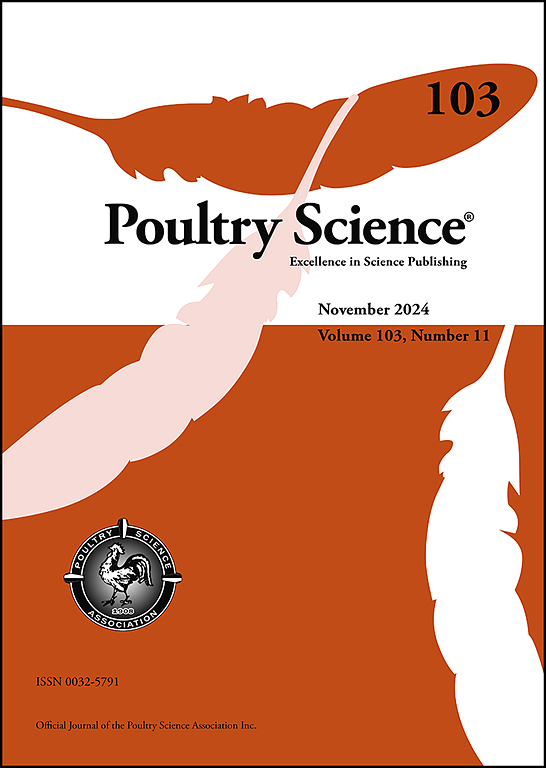Lack of consistency in poultry dust microbial taxa associated with high and low-performing commercial broiler flocks
IF 3.8
1区 农林科学
Q1 AGRICULTURE, DAIRY & ANIMAL SCIENCE
引用次数: 0
Abstract
The microbial communities of the gastrointestinal tract play an essential role in poultry health and productivity. Poultry dust has been used to investigate bacterial taxa associated with performance in commercial broiler farms. This study investigated the commonalities of poultry dust microbial taxa associated with performance in samples collected from three broiler integrator companies and their stability in a successive flock of the same companies using deep sequencing of the 16S rRNA gene. Poultry dust samples (n = 248) were collected on days 14 and 35 of the production cycle from 38 commercial broiler flocks (2 flocks from each of 19 farms). The farms were ranked as low or high performers based on the feed conversion ratio corrected for body weight. Permutational analysis of variance based on Bray-Curtis index using abundance data for bacterial community structure results showed that company explained the most variation in the bacterial community structure (7.5 %), followed by bird age (2 %) and the least variation was explained by performance (1.9 %), with significant interactions among these factors (P < 0.001). No bacterial taxa in high or low-performing farms overlapped in all three companies or successive flocks from the same company. Some taxa associated with high performance in a company were associated with low performance in another company (e.g., Bifidobacterium), corroborating other studies highlighting the lack of universal microbial markers of productivity. In conclusion, there were no consistent microbial taxa across companies and flocks within a company under the conditions of this study.
与高产和低产肉鸡群相关的家禽粉尘微生物类群缺乏一致性
胃肠道微生物群落对家禽的健康和生产率起着至关重要的作用。家禽灰尘已被用于调查与商业肉鸡养殖场生产性能相关的细菌类群。本研究采用 16S rRNA 基因深度测序法,调查了从三家肉鸡一体化公司采集的样本中与生产性能相关的禽尘微生物类群的共性及其在同一家公司连续鸡群中的稳定性。在生产周期的第 14 天和第 35 天,从 38 个商品肉鸡群(19 个农场,每个农场 2 个鸡群)中采集禽尘样本(n = 248)。根据按体重校正后的饲料转化率,将这些农场分为低绩效农场和高效绩效农场。基于布雷-柯蒂斯指数(Bray-Curtis index)和细菌群落结构丰度数据的排列组合方差分析结果显示,公司可解释细菌群落结构的最大变化(7.5%),其次是禽龄(2%),而性能可解释的变化最小(1.9%),这些因素之间存在显著的交互作用(P <0.001)。在三个公司或同一公司的连续鸡群中,没有高绩效或低绩效鸡场的细菌类群重叠。一些与一家公司高绩效相关的分类群在另一家公司却与低绩效相关(如双歧杆菌),这证实了其他研究强调的生产力缺乏通用微生物标记的观点。总之,在本研究的条件下,不同公司和公司内不同菌群之间没有一致的微生物类群。
本文章由计算机程序翻译,如有差异,请以英文原文为准。
求助全文
约1分钟内获得全文
求助全文
来源期刊

Poultry Science
农林科学-奶制品与动物科学
CiteScore
7.60
自引率
15.90%
发文量
0
审稿时长
94 days
期刊介绍:
First self-published in 1921, Poultry Science is an internationally renowned monthly journal, known as the authoritative source for a broad range of poultry information and high-caliber research. The journal plays a pivotal role in the dissemination of preeminent poultry-related knowledge across all disciplines. As of January 2020, Poultry Science will become an Open Access journal with no subscription charges, meaning authors who publish here can make their research immediately, permanently, and freely accessible worldwide while retaining copyright to their work. Papers submitted for publication after October 1, 2019 will be published as Open Access papers.
An international journal, Poultry Science publishes original papers, research notes, symposium papers, and reviews of basic science as applied to poultry. This authoritative source of poultry information is consistently ranked by ISI Impact Factor as one of the top 10 agriculture, dairy and animal science journals to deliver high-caliber research. Currently it is the highest-ranked (by Impact Factor and Eigenfactor) journal dedicated to publishing poultry research. Subject areas include breeding, genetics, education, production, management, environment, health, behavior, welfare, immunology, molecular biology, metabolism, nutrition, physiology, reproduction, processing, and products.
 求助内容:
求助内容: 应助结果提醒方式:
应助结果提醒方式:


